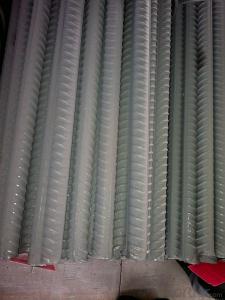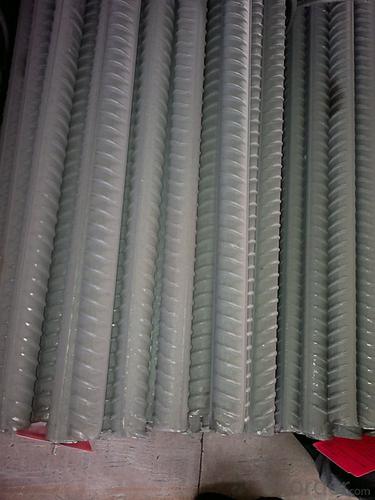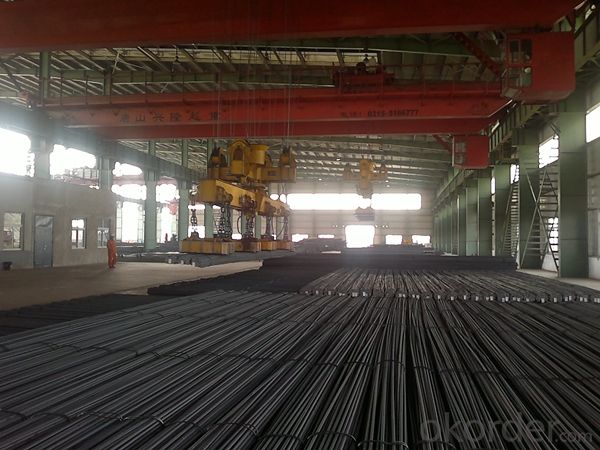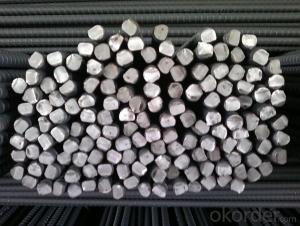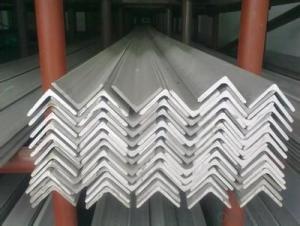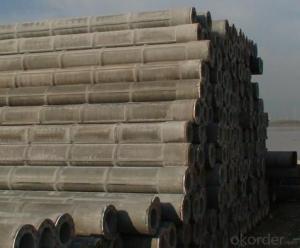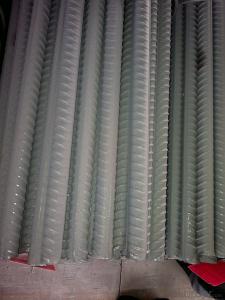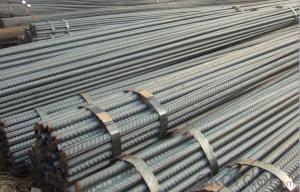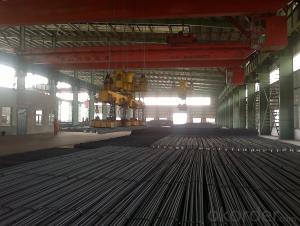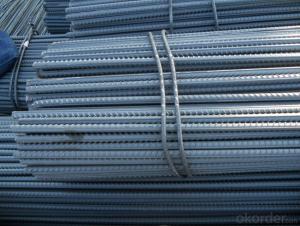Hot Rolled BS4449 Standard Deformed Steel Rebars for Construction
- Loading Port:
- Tianjin
- Payment Terms:
- TT OR LC
- Min Order Qty:
- 25 m.t.
- Supply Capability:
- 200000 m.t./month
OKorder Service Pledge
OKorder Financial Service
You Might Also Like
Product Description:
OKorder is offering Hot Rolled GB Standard Deformed Steel Rebars for Construction at great prices with worldwide shipping. Our supplier is a world-class manufacturer of steel, with our products utilized the world over. OKorder annually supplies products to European, North American and Asian markets. We provide quotations within 24 hours of receiving an inquiry and guarantee competitive prices.
Product Applications:
Hot Rolled GB Standard Deformed Steel Rebars for Construction are ideal for structural applications and are widely used in the construction of buildings and bridges, and the manufacturing, petrochemical, and transportation industries.
1. Supporting members, most commonly in the house raising industry to strengthen timber bears under houses. Transmission line towers, etc
2. Prefabricated structure
3. Medium scale bridges
4. It is widely used in various building structures and engineering structures such as roof beams, bridges, transmission towers, hoisting machinery and transport machinery, ships, industrial furnaces, reaction tower, container frame and warehouse etc.
Product Advantages:
Hot Rolled GB Standard Deformed Steel Rebars for Construction are durable, strong, and resist corrosion.
Main Product Features:
· Premium quality
· Prompt delivery & seaworthy packing (30 days after receiving deposit)
· Corrosion resistance
· Can be recycled and reused
· Mill test certification
· Professional Service
· Competitive pricing
Product Specifications:
Our supplier is a world-class manufacturer of steel, with our products utilized the world over. OKorder annually supplies products to European, North American and Asian markets. We provide quotations within 24 hours of receiving an inquiry and guarantee competitive prices.
Product Applications:
High Quality Hot Rolled Equal Angle Steel Bars for Strcuture are ideal for structural applications and are widely used in the construction of buildings and bridges, and the manufacturing, petrochemical, and transportation industries.
1. Supporting members, most commonly in the house raising industry to strengthen timber bears under houses. Transmission line towers, etc
2. Prefabricated structure
3. Medium scale bridges
4. It is widely used in various building structures and engineering structures such as roof beams, bridges, transmission towers, hoisting machinery and transport machinery, ships, industrial furnaces, reaction tower, container frame and warehouse etc.
Product Advantages:
High Quality Hot Rolled Equal Angle Steel Bars for Constrcution are durable, strong, and resist corrosion.
Main Product Features:
· Premium quality
· Prompt delivery & seaworthy packing (30 days after receiving deposit)
· Corrosion resistance
· Can be recycled and reused
· Mill test certification
· Professional Service
· Competitive pricing
Product Specifications:
Specifications of Hot Rolled GB Standard Deformed Steel Rebars for Construction:
Standard | GB UK USA | HRB335 HRB400 HRB500 G460B, B500A, B500B,B500C GR40, GR60 | |
Diameter | 6mm,8mm,10mm,12mm,14mm,16mm,18mm,20mm, 22mm,25mm,28mm,32mm,36mm,40mm,50mm | ||
Length | 6M, 9M,12M or as required | ||
Packing | Export standard packing: wrapped by wire rod in bundles | ||
Each bundle weight | 2-3MT, or as required | ||
Trade terms | FOB, CFR, CIF | ||
Payment terms | TT payment in advance or Irrevocable LC at sight. | ||
Delivery Detail | within 45 days after received advanced payment or LC. | ||
Brand name | DRAGON | ||
Theoretical weight and section area of each diameter as below for your information:
Diameter(mm) | Section area (mm²) | Mass(kg/m) | Weight of 12m (kg) | Pcs/ton |
6 | 28.27 | 0.222 | 2.664 | 375.38 |
8 | 50.27 | 0.395 | 4.74 | 210.97 |
10 | 78.54 | 0.617 | 7.404 | 135.06 |
12 | 113.1 | 0.888 | 10.656 | 93.84 |
14 | 153.9 | 1.21 | 14.52 | 68.87 |
16 | 201.1 | 1.58 | 18.96 | 52.74 |
18 | 254.5 | 2.00 | 24 | 41.67 |
20 | 314.2 | 2.47 | 29.64 | 33.74 |
22 | 380.1 | 2.98 | 35.76 | 27.96 |
25 | 490.9 | 3.85 | 46.2 | 21.65 |
28 | 615.8 | 4.83 | 57.96 | 17.25 |
32 | 804.2 | 6.31 | 75.72 | 13.21 |
36 | 1018 | 7.99 | 98.88 | 10.43 |
40 | 1257 | 9.87 | 118.44 | 8.44 |
50 | 1964 | 15.42 | 185.04 | 5.40 |
Chemical Composition: (Please kindly find our chemistry of our material based on JIS as below for your information)
JISG3112 SD390 | Chemical Composition | ||||
C | Mn | Si | S | P | |
0.22 | 1.38 | 0.4 | 0.014 | 0.022 | |
Physical capability | |||||
Yield Strength(N/cm²) | Tensile Strength(N/cm²) | Elongation (%) | |||
620 | ≥400 | 21 | |||
Usage and Applications of Hot Rolled GB Standard Deformed Steel Rebars for Construction:
Deformed bar is widely used in buildings, bridges, roads and other engineering construction. Big to highways, railways, bridges, culverts, tunnels, public facilities such as flood control, dam, small to housing construction, beam, column, wall and the foundation of the plate, deformed bar is an integral structure material. With the development of world economy and the vigorous development of infrastructure construction, real estate, the demand for deformed bar will be larger and larger..
Packaging & Delivery of Hot Rolled GB Standard Deformed Steel Rebars for Construction:
Packaging Detail: products are packed in bundle and then shipped by container or bulk vessel, deformed bar is usually naked strapping delivery, when storing, please pay attention to moisture proof. The performance of rust will produce adverse effect.
Price: Keep lower operating costs so as to offer competitive price for our clients
Deformed Steel Rebars according to Korean standard
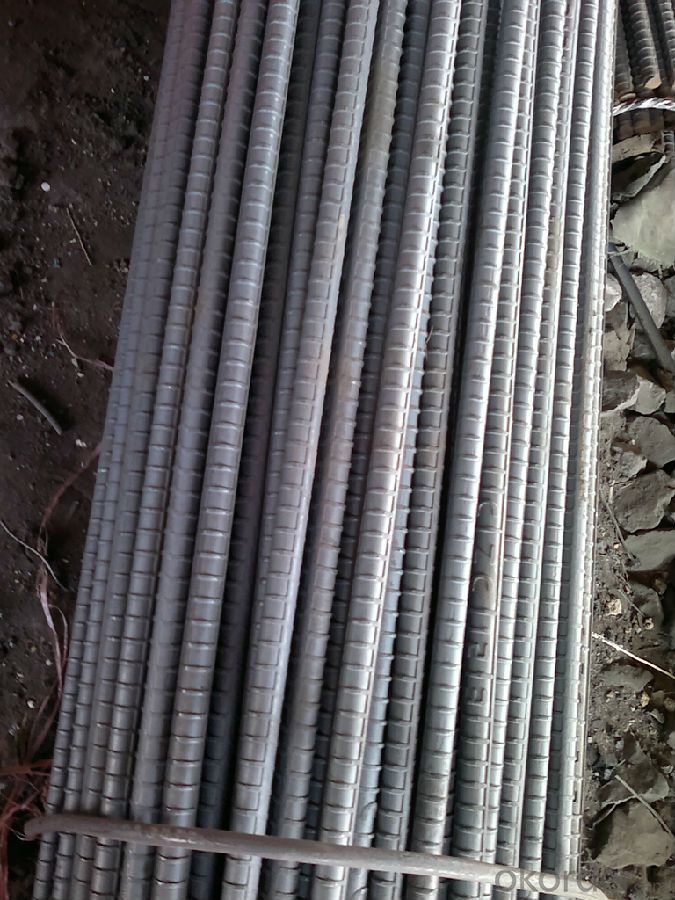
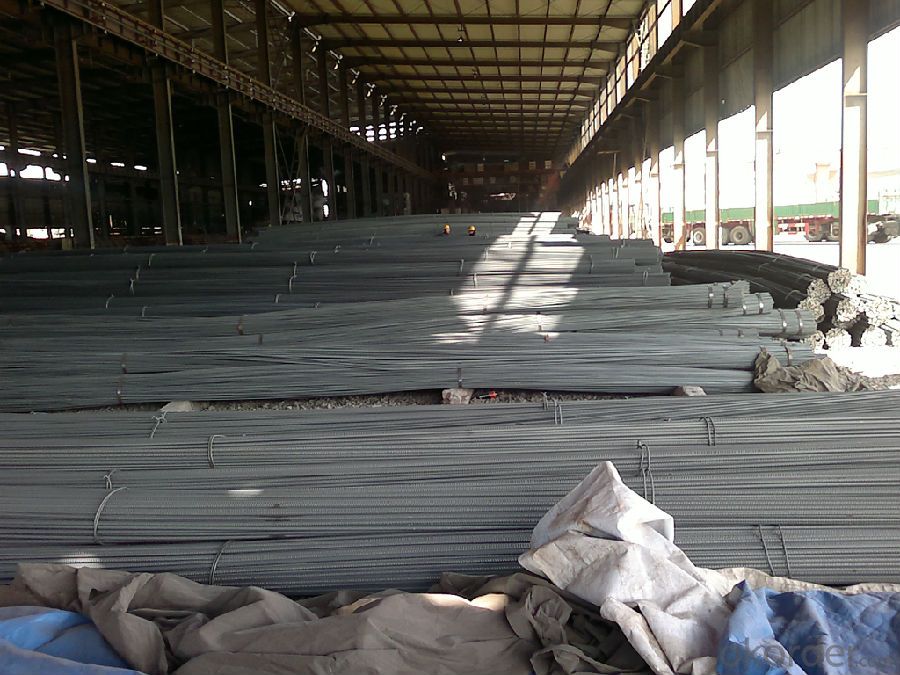
Note:
1. Our products are produced according to national standard (GB), if not, supply according to national standards (GB) or agreement as customer required.
2. Other Grade and Standard Deformed Steel Bar we can supply:
Grade: GR40/GR60, G460B/B500A/B500B/B500C,BST500S
Standard: ASTM, BS, DIN
The Minimum Order Quantity of these products is high, and need to be confirmed.
3. We can not only supply Deformed Steel Bar; if you need anything about building materials, please contact us for further information.
4. Please send us your detail specifications when inquire. We will reply to you as soon as possible. We sincerely hope we can establish a long stable business relationship.
- Q: How are steel rebars used in elevator shafts?
- Steel rebars are used in elevator shafts to reinforce the concrete structure and provide strength and stability. They are embedded within the concrete walls to prevent cracking or collapsing, ensuring the safety and durability of the elevator shaft.
- Q: Are steel rebars suitable for use in high-temperature applications?
- Steel rebars are generally not suitable for use in high-temperature applications. Although steel is a strong and durable material, it has limitations when exposed to high temperatures. At elevated temperatures, steel can undergo significant reduction in strength and may even experience a loss of structural integrity, leading to potential failures. When steel is exposed to high temperatures, it undergoes a process called thermal expansion, which can cause it to weaken and deform. This phenomenon is particularly prominent in rebars, which are often used as reinforcements in concrete structures. The high temperatures can cause the rebars to expand and exert excessive pressure on the surrounding concrete, leading to cracks and potentially compromising the structure's stability. Additionally, prolonged exposure to high temperatures can result in a loss of the steel's mechanical properties, including tensile strength and load-bearing capacity. This can significantly reduce the rebars' ability to resist external forces and effectively reinforce the concrete. Therefore, it is generally recommended to use alternative materials, such as stainless steel or special alloys, for high-temperature applications. These materials are specifically designed to withstand elevated temperatures without losing their structural integrity. It is important to consult with experts and engineers familiar with high-temperature applications to determine the most suitable materials for specific projects to ensure safety and structural stability.
- Q: Can steel rebars be used in the construction of offshore oil platforms?
- Yes, steel rebars can be used in the construction of offshore oil platforms. Steel rebars provide structural reinforcement and enhance the strength and stability of the platform's concrete foundation. They are commonly used in various offshore structures due to their high tensile strength, durability, and resistance to corrosion in marine environments. Additionally, steel rebars can be designed to meet specific engineering requirements and contribute to the overall safety and longevity of the offshore oil platform.
- Q: How do steel rebars perform in extreme weather conditions?
- Steel rebars perform well in extreme weather conditions. The steel's strength and durability allow it to withstand both high and low temperatures, as well as intense wind, rain, and snow. This makes steel rebars a reliable choice for construction projects in areas prone to hurricanes, storms, and other extreme weather events.
- Q: What is the process of anchoring steel rebars in concrete?
- The process of anchoring steel rebars in concrete involves several steps. First, the rebars are cut to the required length and bent as per the structural design. Next, the concrete formwork is prepared, ensuring it is clean and free from any debris. Once the formwork is ready, the rebars are carefully placed and positioned within the formwork according to the specified spacing and alignment. They are usually supported by chairs or spacers to maintain the desired position. After the rebars are properly positioned, the formwork is secured, and concrete is poured, ensuring it completely surrounds and covers the rebars. The concrete is then allowed to cure and harden, providing a strong bond between the steel rebars and the concrete. Ultimately, the process of anchoring steel rebars in concrete involves proper planning, positioning, and securing of the rebars within the formwork, followed by pouring and curing of the concrete to create a robust and durable structure.
- Q: How do steel rebars contribute to the seismic performance of concrete buildings?
- Steel rebars play a crucial role in enhancing the seismic performance of concrete buildings. They provide reinforcement to concrete structures, making them more resistant to seismic forces. During an earthquake, the ground shakes violently, exerting horizontal and vertical forces on the building. These forces can cause the concrete to crack or even collapse if not properly reinforced. Steel rebars are used to strengthen the concrete and mitigate the effects of seismic activity. The rebars are strategically placed within the concrete, forming a mesh-like network that increases the tensile strength of the structure. Concrete is strong in compression but weak in tension, whereas steel has excellent tensile strength. By combining the two materials, the rebars help to distribute the seismic forces more evenly throughout the concrete, preventing cracks from propagating and providing a more ductile behavior. In addition to improving the tensile strength, steel rebars also enhance the overall stiffness of the structure. This stiffness helps to reduce the building's response to vibrations during an earthquake, minimizing the potential for damage. The rebars act as a backbone for the concrete, increasing its resistance to deformation and improving the building's overall structural integrity. Moreover, steel rebars also contribute to the ductility of the structure. Ductility refers to the ability of a material to deform under stress without losing its structural integrity. During an earthquake, the building undergoes significant displacement and deformation. Steel rebars allow the concrete to flex and absorb the energy from seismic forces without catastrophic failure. This ductile behavior ensures that the building can withstand the shaking and provides occupants with more time to evacuate safely. Overall, steel rebars are crucial in enhancing the seismic performance of concrete buildings. They improve the tensile strength, stiffness, and ductility of the structure, reducing the risk of damage or collapse during an earthquake. By reinforcing the concrete, steel rebars play a vital role in ensuring the safety and resilience of concrete buildings in seismic-prone areas.
- Q: Can steel rebars be painted or coated?
- Yes, steel rebars can be painted or coated. Painting or coating steel rebars helps to protect them from corrosion and extend their lifespan. It is a common practice in construction and reinforcement projects to apply paint or protective coatings on steel rebars to enhance their durability and resistance to environmental factors.
- Q: Can steel rebars be used in water treatment plant construction?
- Yes, steel rebars can be used in water treatment plant construction. Steel rebars are commonly used as reinforcement in concrete structures, including those in water treatment plants. These rebars provide strength and durability to concrete structures, ensuring they can withstand the various stresses and loads imposed on them. Moreover, steel rebars are resistant to corrosion, which is essential in water treatment plants where exposure to water and chemicals is common. However, it is important to ensure that the rebars used in the construction of water treatment plants meet the required specifications and standards to ensure the longevity and integrity of the structures.
- Q: Are steel rebars suitable for reinforcement in schools and educational buildings?
- Yes, steel rebars are suitable for reinforcement in schools and educational buildings. Steel rebars provide strength and durability to the structure, making it capable of withstanding heavy loads and ensuring the safety of the occupants. Additionally, steel rebars are cost-effective, widely available, and easy to install, making them a preferred choice for reinforcement in educational buildings.
- Q: Can steel rebars be used in heritage bridge restoration?
- Yes, steel rebars can be used in heritage bridge restoration. Steel rebars provide strength and durability to the structure, making them an ideal choice for reinforcing and ensuring the safety of heritage bridges.
Send your message to us
Hot Rolled BS4449 Standard Deformed Steel Rebars for Construction
- Loading Port:
- Tianjin
- Payment Terms:
- TT OR LC
- Min Order Qty:
- 25 m.t.
- Supply Capability:
- 200000 m.t./month
OKorder Service Pledge
OKorder Financial Service
Similar products
Hot products
Hot Searches
Related keywords
